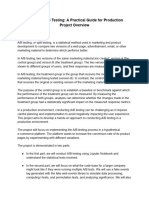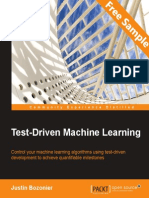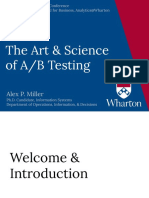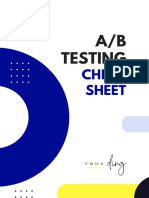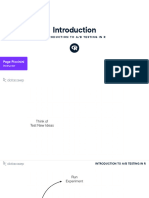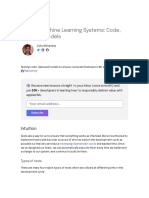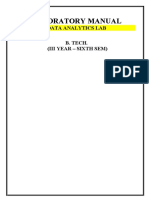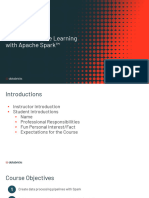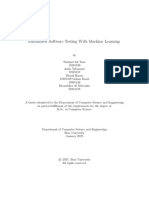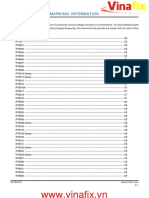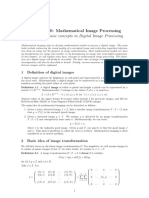AB Testing in ML
A/B test in Machine learning
A/B testing is a statistical method used in machine learning and data science to compare two versions (A
and B) of a variable to determine which one performs better in a controlled experiment. It is widely used
for decision-making in areas like product design, marketing strategies, and model performance
evaluation.
Key Components of A/B Testing
1. Control Group (A): The baseline or original version used for comparison.
2. Treatment Group (B): The modified or experimental version being tested.
3. Metric: The measurable outcome or success criterion, such as click-through rate (CTR), conversion
rate, or error rate.
4. Randomization: Users or data points are randomly assigned to A or B to avoid bias.
5. Hypothesis Testing:
Null Hypothesis (H₀): Assumes no difference between A and B.
Alternative Hypothesis (H₁): Assumes a significant difference between A and B.
Steps for A/B Testing in Machine Learning
1. Define Objective: Clearly state the goal, e.g., increasing model accuracy or improving user
engagement.
2. Identify Metric: Select the key performance indicator (KPI) to measure success.
3. Random Sampling: Randomly assign samples to the control (A) and treatment (B) groups.
4. Implement Changes: Apply the proposed change to the treatment group.
5. Run Experiment: Collect data for a sufficient duration to ensure statistical significance.
6. Analyze Results:
Compare the performance of A and B.
Use statistical methods like t-tests or Chi-square tests to evaluate significance.
7. Make Decisions: Based on the results, decide whether to adopt the change or keep the original
version.
Use Case in Machine Learning
Example: Model Performance Improvement
Goal: Evaluate if a new machine learning model (B) performs better than the existing model (A).
Metric: Model accuracy, precision, or recall.
Process:
1. Split the dataset into two groups: one for model A and another for model B.
Printed using ChatGPT to PDF, powered by PDFCrowd HTML to PDF API. 1/2
� 2. Deploy both models and collect performance data.
3. Use statistical testing to compare metrics.
Python Implementation
Here’s a basic example of performing an A/B test using Python:
python
import numpy as np
from scipy.stats import ttest_ind
# Simulated data
control_group = np.random.normal(loc=50, scale=5, size=100) # Group A
treatment_group = np.random.normal(loc=52, scale=5, size=100) # Group B
# Calculate mean and standard deviation
mean_control = np.mean(control_group)
mean_treatment = np.mean(treatment_group)
print(f"Control Mean: {mean_control}")
print(f"Treatment Mean: {mean_treatment}")
# Perform t-test
t_stat, p_value = ttest_ind(control_group, treatment_group)
print(f"T-Statistic: {t_stat}")
print(f"P-Value: {p_value}")
# Decision
if p_value < 0.05:
print("Reject the null hypothesis: Significant difference exists.")
else:
print("Fail to reject the null hypothesis: No significant difference.")
Advantages
Provides quantitative evidence for decision-making.
Reduces risk by testing changes before full deployment.
Applicable to both online experiments and offline evaluations.
Challenges
Requires careful experimental design to avoid biases.
Needs sufficient sample size for statistical significance.
Confounding variables can lead to incorrect conclusions.
A/B testing is a powerful tool for optimizing machine learning models and business processes, enabling
data-driven decisions that improve performance and user satisfaction.
Printed using ChatGPT to PDF, powered by PDFCrowd HTML to PDF API. 2/2



